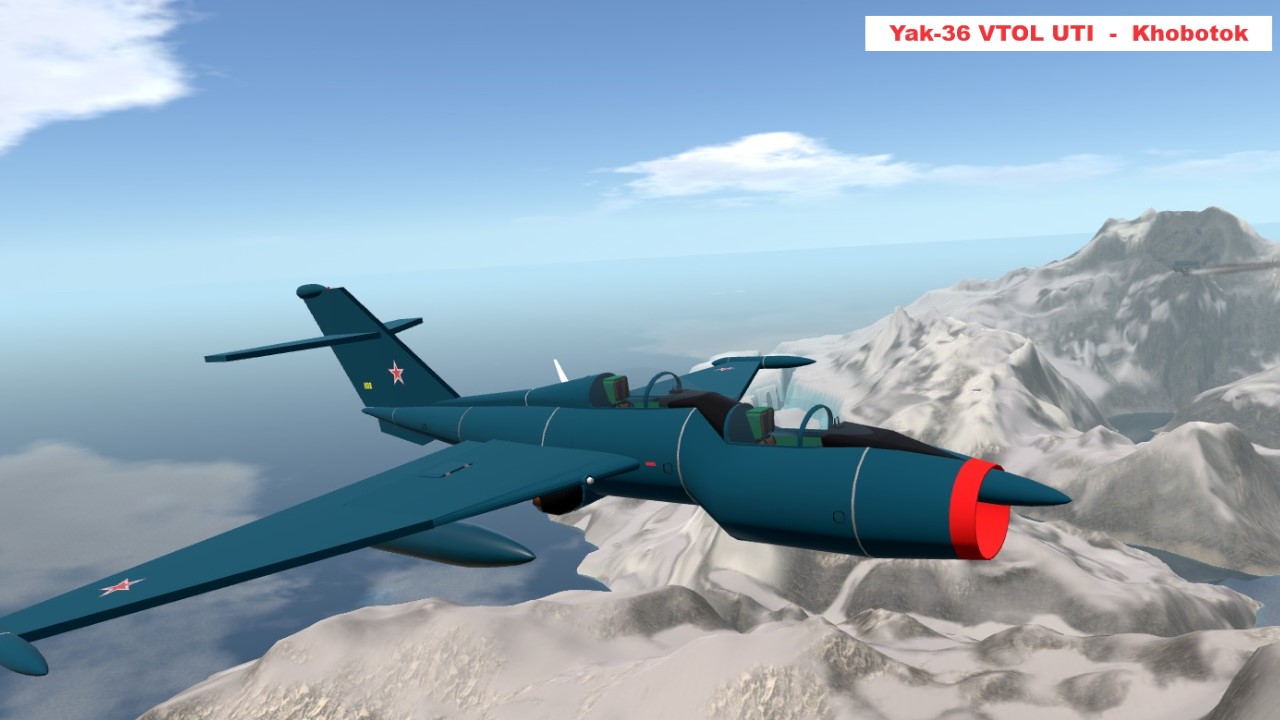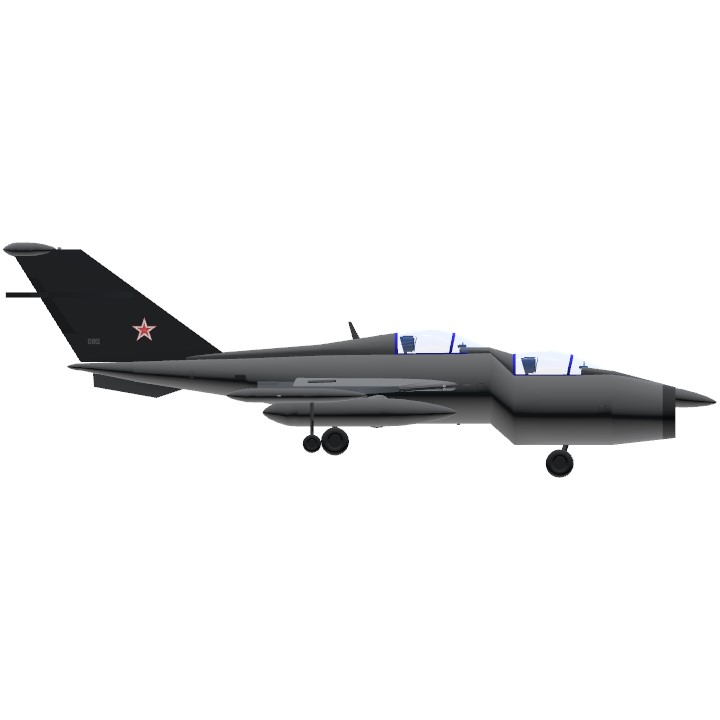( English version at the bottom of the page )
Deuxième version UTI de cet avion avec maintenant deux postes de cockpits complets et un pilotage digne d'un vrai prototype des années 1960 . Voici le " Khobotok " .
l'Amérique et la France ne considèrent pas sérieusement l'aéronautique de combat VTOL . L'Angleterre par contre s'y intéressa très tôt .
Impressionné et inspiré par la performance du British Short SC , l'avion de recherche VTOL , Les russes lancèrent le programme Soviet VTOL .
Le responsable de la défense , Dmitri Ustinov, a commandé le programme de recherche Soviet VTOL .
Cet avion a été équipé d'un moteur fixe monté verticalement , de buses rotatives et d'un fuselage conventionnel .
La base utilisé était le Yak 30 , nommé Yak-30 V pour (vertikalnyi , vertical) , avant d'être renuméroté Yak-36 .
En 1961 se sont déroulés les premier essai de vol du Hawker P. 1127 , prototype de recherche , qui aboutira au Harrier .
Quatre avions de recherche Yak-36 ont été construits , en comptant la cellule de test statique .
Le premier spécimen de vol a été achevé en 1962 et ses premiers tests en vol stationnaire ont été fait, attaché au sol .
Le 24 Mars 1966 , un décollage vertical avec une transition complète , un vol horizontal , puis retour avec vol stationnaire et un atterrissage vertical a été achevé .
Ces prototypes ont donné beaucoup de expérience dans la conception de VTOL .
Ces avions ont affiché des mauvaises performances : leur plafond n'était que d'environ (39 370 pieds) et l'autonomie restait faible .
De plus , le pilotage restait complexe , notamment pendant les phases de transitions de vol .
Quelques brefs essais du Yak-36 ont été fait à bord du croiseur hélicoptère Moskva .
Un exemplaire a participé en Juillet 1967 à la parade aérienne de Domodedovo . Cela a révélé au public
l'existence de cet appareil . Peu de temps après , le Yak-36M et Yak-38 a reçu d'Occident le nom de code Freehand .
Cellule modifiée , deux postes de pilotages complets, et un look de fer à repasser . C'est avion a été surnommé " Khobotok " en russe par ces pilotes ,
Nasique en Français . Le Nasique un singe originaire d'Asie au nez proéminent , ressemblent fortement au nez du Yak 36 UTI .
Décollage vertical : réacteurs orientés vers le bas ( VTOl bas ) , puissance à environ 20% , contrôler avec pitch jusqu'à environ 500 ft , orienter les
réacteurs horizontalement ( VTOL milieu ) et augmenter le puissance .
Atterrissage : approche réacteur environ 15% ( ajuster en fonction de la vitesse de descente ) , aérofrein sorti , réduire la vitesse à 80 mph , contrôler l'inclinaison de l'avion avec les réacteurs , à 250 ft , ouvrir le parachute et couper les gaz .
Les ingénieurs de l'OKB Yakovlev non jamais réussi à faire atterrir correctement cet avion ( … moi non plus , le surpoids provoqué par le deuxième poste de pilotage à été fatal au prototype numéroté 002 . Il s'écrasa lors de son cinquièmes vol . Il fut détruit totalement . Heureusement l'équipages s'en est sorti indemne .
Réacteur : touche 1 .
Feux de navigation : touche 2 .
Feux d'atterrissage : touche 3 .
Ejection réservoirs externes : touche 4 .
Verrouillage train avant : touche 5 .
Parachute : touche 6 .
Aérofreins : touche 7 + Trim bas .
Fermeture et ouverture cockpit : touche 8 .
Orientation tuyères : vtol .
Trim : trim
English Version :
Second UTI version of this aircraft now with two complete cockpit positions and piloting worthy of a real prototype from the 1960s. Here is the “Khobotok”.
America and France do not seriously consider VTOL combat aeronautics. England, on the other hand, took an interest in it very early on.
Impressed and inspired by the performance of the British Short SC, the VTOL research aircraft, the Russians launched the Soviet VTOL program.
Defense official Dmitry Ustinov commanded the Soviet VTOL research program.
This aircraft was fitted with a vertically mounted fixed engine, rotating nozzles and a conventional fuselage.
The base used was the Yak 30, named Yak-30 V for (vertikalnyi, vertical), before being renumbered Yak-36.
In 1961, the first flight tests of the Hawker P. 1127, a research prototype, which would lead to the Harrier, took place.
Four Yak-36 research aircraft were built, including the static test cell.
The first flying specimen was completed in 1962 and its first hover tests were made, tethered to the ground.
On March 24, 1966, a vertical takeoff with a full transition, horizontal flight, then return with hover and vertical landing was completed.
These prototypes provided a lot of experience in VTOL design.
These planes performed poorly: their ceiling was only around (39,370 feet) and the autonomy remained low.
In addition, piloting remained complex, particularly during flight transition phases.
Some brief tests of the Yak-36 were made aboard the helicopter cruiser Moskva.
One example participated in the Domodedovo air parade in July 1967. This revealed to the public
the existence of this device. Shortly after, the Yak-36M and Yak-38 received the code name Freehand from the West.
Modified cell, two complete cockpits, and an iron look. This plane was nicknamed "Khobotok" in Russian by these pilots,
Nasique in French. The Proboscis monkey, a monkey native to Asia with a prominent nose, strongly resembles the nose of the Yak 36 UTI.
Vertical takeoff: engines oriented downwards (low VTOl), power at approximately 20%, control with pitch up to approximately 500 ft, direct the
reactors horizontally (VTOL middle) and increase the power.
Landing: engine approach approximately 15% (adjust according to descent speed), airbrake extended, reduce speed to 80 mph, control the plane's inclination with the engines, at 250 ft, open the parachute and cut the gas .
The OKB Yakovlev engineers never managed to land this plane correctly (… me neither, the excess weight caused by the second cockpit was fatal to the prototype numbered 002. It crashed during its fifth flight. It was completely destroyed. Fortunately the crew escaped unscathed.
Reactor: key 1.
Navigation lights: button 2.
Landing lights: key 3.
Ejection of external tanks: key 4.
Front axle lock: button 5.
Parachute: key 6.
Airbrakes: button 7 + Trim down.
Closing and opening cockpit: button 8.
Nozzle orientation: vtol.
Trim: trim
Specifications
Spotlights
- Rjenteissussy 1.4 years ago
General Characteristics
- Predecessor Yak-36 VTOL prototype 2
- Created On Windows
- Wingspan 41.8ft (12.8m)
- Length 41.5ft (12.7m)
- Height 13.7ft (4.2m)
- Empty Weight 5,731lbs (2,599kg)
- Loaded Weight 7,621lbs (3,457kg)
Performance
- Power/Weight Ratio 10.614
- Wing Loading 31.8lbs/ft2 (155.4kg/m2)
- Wing Area 239.5ft2 (22.3m2)
- Drag Points 5642
Parts
- Number of Parts 309
- Control Surfaces 7
- Performance Cost 1,313







@dots , thank for your upvote .
@XEPOH , Thanks for your upvote .
@DDragonsAS , thank for your upvote .
@Chaunhkhoa , thank for your upvote .
@Trainzo of course my friend 😁
@UseGooglePlay , thank for your upvote .
@ouioui126 , thank for your upvote .
@ouioui126 , thank for your comment .
Nice plane .
@STALIN83 , thnak for your upvote and your comment bro .
Coll trainet plane👍🏻👍🏻
@Vitto191 , thank for your upvote .
@OkaNieba , @PrussianAirlines , @SomeSPGuyWhoLikesLore , thanks for yours upvotes .
@Rjenteissussy , thank for have spotlighted my plane .
@Trainzo ywww :))
@Trainzo ok
@Trainzo no probs ;)
@Vikram123 , thank for your upvote .
@Ownedpilot , @SuperSuperTheSylph , @Rjenteissussy , thanks for yours upvotes .
@C47skytrain , @ Pakkoyan , @FlatterGuy , thanks for yours upvotes .
@PannerTerkins , thank , I also forgot to delete this line once the Google translation was done.
This [![2104-6e591a4e6cff4c25d54fe0f1f1310822.jpg]
Should be this. FIF(jpeg)
The F’s are []
@IQinventory , thank for your upvote and your comment .
I should make this plane.
very nice